Sprouts might seem like just a simple garnish or a crunchy salad topping, but these tiny plants pack a serious nutritional punch. Even more impressive? You can grow them right at home – no green thumb or garden required. From improving digestion to boosting detoxification, sprouts are one of nature’s most underrated superfoods. And among them, broccoli sprouts stand out as a heavy-hitting source of sulforaphane, a compound with potent health-protective benefits (we’ll get into that later).
In this guide, you’ll learn exactly how to grow your own sprouts at home and why incorporating them into your daily diet could be a game-changer for your long-term health.
What Are Sprouts?
Sprouts are young seedlings of vegetables, legumes, or grains that have just begun to grow. When seeds are soaked in water and allowed to germinate for a few days, they transform into sprouts – nutrient-dense living foods that are often eaten raw.
Popular types of sprouts include: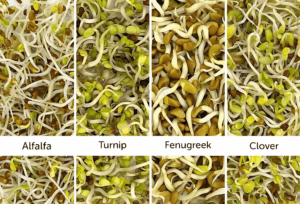
- Alfalfa
- Mung bean
- Lentil
- Clover
- Radish
- Broccoli
- Sunflower
- Fenugreek
Each type has its own unique flavor, texture, and nutritional profile, but all of them are powerhouses – rich in enzymes, antioxidants, vitamins, and minerals.
Why Sprouts Are a Nutritional Powerhouse
Sprouting seeds unlocks their full nutritional potential. Here’s why sprouts are so beneficial:
Rich in Enzymes
Sprouts are loaded with enzymes that support digestion and help your body better absorb nutrients. Enzymes begin breaking down macronutrients like carbs, proteins, and fats, taking the load off your digestive system.
High in Antioxidants
Sprouts contain antioxidants such as flavonoids and polyphenols that help neutralize free radicals, reducing oxidative stress and lowering the risk of chronic diseases.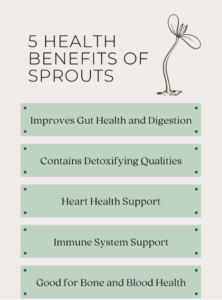
Packed with Vitamins and Minerals
During the sprouting process, seeds often experience a surge in vitamin content, especially vitamins A, B, C, and E. They’re also a good source of potassium, magnesium, iron, and calcium.
Improved Bioavailability
Sprouting reduces anti-nutrients like phytic acid and lectins that can inhibit the absorption of minerals. This means your body gets more of the good stuff.
Boosts Detoxification
Certain sprouts, particularly broccoli sprouts, enhance the body’s natural detoxification pathways thanks to their high content of glucosinolates.
How to Grow Sprouts at Home: A Step-by-Step Guide
One of the best parts about sprouts is how easy and inexpensive they are to grow at home. Here’s how to do it: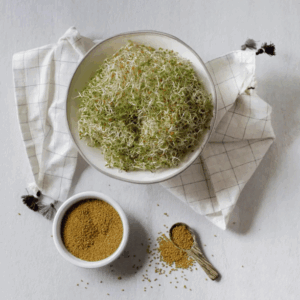
What You’ll Need:
- Organic sprouting seeds (broccoli, alfalfa, radish, etc.)
- A wide-mouth glass jar
- A mesh lid or cheesecloth and a rubber band
- Clean water
Step-by-Step Instructions:
- Measure and Soak: Add 1–2 tablespoons of seeds into your jar. Cover with about 3x as much water and let them soak overnight (8–12 hours) in a dark place.
- Drain and Rinse: The next morning, drain the water through your mesh lid or cheesecloth. Rinse with fresh water and drain again.
- Repeat the Rinse-Drain Cycle: Place the jar upside down at an angle (in a dish rack or bowl) to allow excess water to drain and air to circulate. Repeat the rinse-and-drain process 2–3 times per day.
- Watch Them Grow: Within 3–5 days, your sprouts should be fully grown and ready to harvest. When they’re about 1–2 inches long and have small green leaves, they’re good to go.
- Store and Eat: Once grown, rinse your sprouts well and let them dry before storing in the fridge. They’ll stay fresh for about a week.
How to Use Sprouts in Your Diet
Sprouts are incredibly versatile. You can:
- Add them to salads for a crunchy texture
- Blend them into smoothies for a nutrient boost
- Pile them onto sandwiches or wraps
- Use them as a garnish for soups, omelets, or stir-fry dishes
- Snack on them plain with a drizzle of EVOO (extra virgin olive oil) and sea salt
Spotlight on Broccoli Sprouts
Broccoli sprouts deserve special attention. While mature broccoli can be a healthy choice, its sprouted version is exponentially more potent in one specific compound: sulforaphane.
What Is Sulforaphane?
Sulforaphane is a sulfur-rich compound formed when the enzyme myrosinase acts on glucoraphanin, a glucosinolate found in cruciferous vegetables like broccoli, kale, and brussel sprouts. Broccoli sprouts contain up to 100 times more glucoraphanin than mature broccoli.
When you chew or blend broccoli sprouts, you activate this enzyme reaction, triggering the release of sulforaphane.
“Brassicales contain a myrosinase enzyme that hydrolyzes glucosinolates to form toxic isothiocyanates (ITC), as a defense against bacteria, fungi, insects and herbivores including man. Low levels of ITC trigger a host defense system in mammals that protects them against chronic diseases. Because humans typically cook their brassica vegetables, destroying myrosinase, there is a great interest in determining how human microbiota can hydrolyze glucosinolates and release them, to provide the health benefits of ITC.” – Myrosinase-dependent and –independent formation and control of isothiocyanate products of glucosinolate hydrolysis PMCID: PMC4593958 PMID: 26500669
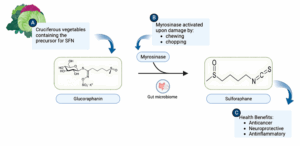
The Health Benefits of Sulforaphane
Sulforaphane is one of the most well-researched plant compounds in nutritional science today. Its potential benefits include:
Cancer Prevention
Sulforaphane has been shown to support phase II detoxification enzymes, which help neutralize carcinogens before they damage DNA. It also inhibits histone deacetylase (HDAC), an enzyme linked to cancer cell growth.
Brain Health
Studies suggest sulforaphane crosses the blood-brain barrier and may help reduce inflammation in the brain, offering potential therapeutic support for conditions like Autism, Alzheimer’s, and Depression.
Detox Support
Sulforaphane enhances the liver’s detox capacity, helping clear out environmental toxins, pollutants, and even endocrine disruptors.
Heart Protection
Sulforaphane supports cardiovascular health by lowering inflammation and oxidative stress, improving cholesterol profiles, and protecting blood vessel function.
Anti-Inflammatory Power
Chronic inflammation is at the root of many diseases. Sulforaphane activates the Nrf2 pathway, which turns on a host of antioxidant and anti-inflammatory genes.
Tips for Getting the Most Sulforaphane
To maximize sulforaphane levels:
- Eat broccoli sprouts raw or lightly steamed (high heat destroys the enzyme myrosinase).
- Chew thoroughly or blend in smoothies to fully activate the sulforaphane formation.
Add a pinch of mustard seed powder or chiles to cooked broccoli to reintroduce the myrosinase enzyme. There’s evidence that pairing spicy food with brassicas increases enzyme power.
Final Thoughts: A Small Habit with Big Impact
We all know enzymes help us digest food and protect our health, so why not grow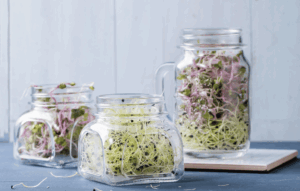 foods that provide them naturally? In a world filled with overpriced superfood powders and miracle supplement marketing, sprouts offer a refreshingly simple and affordable way to boost your health. Growing your own ensures freshness, sustainability, and zero exposure to pesticides or packaging contaminants – not to mention that it’s easy and affordable to do.
foods that provide them naturally? In a world filled with overpriced superfood powders and miracle supplement marketing, sprouts offer a refreshingly simple and affordable way to boost your health. Growing your own ensures freshness, sustainability, and zero exposure to pesticides or packaging contaminants – not to mention that it’s easy and affordable to do.
So if you’re looking to supercharge your nutrient intake, improve digestion, and support your body’s natural detox systems, start with sprouts. And if you’re looking for a single type to start with, definitely go for broccoli sprouts. Your gut, brain, liver, and long-term health will thank you.








